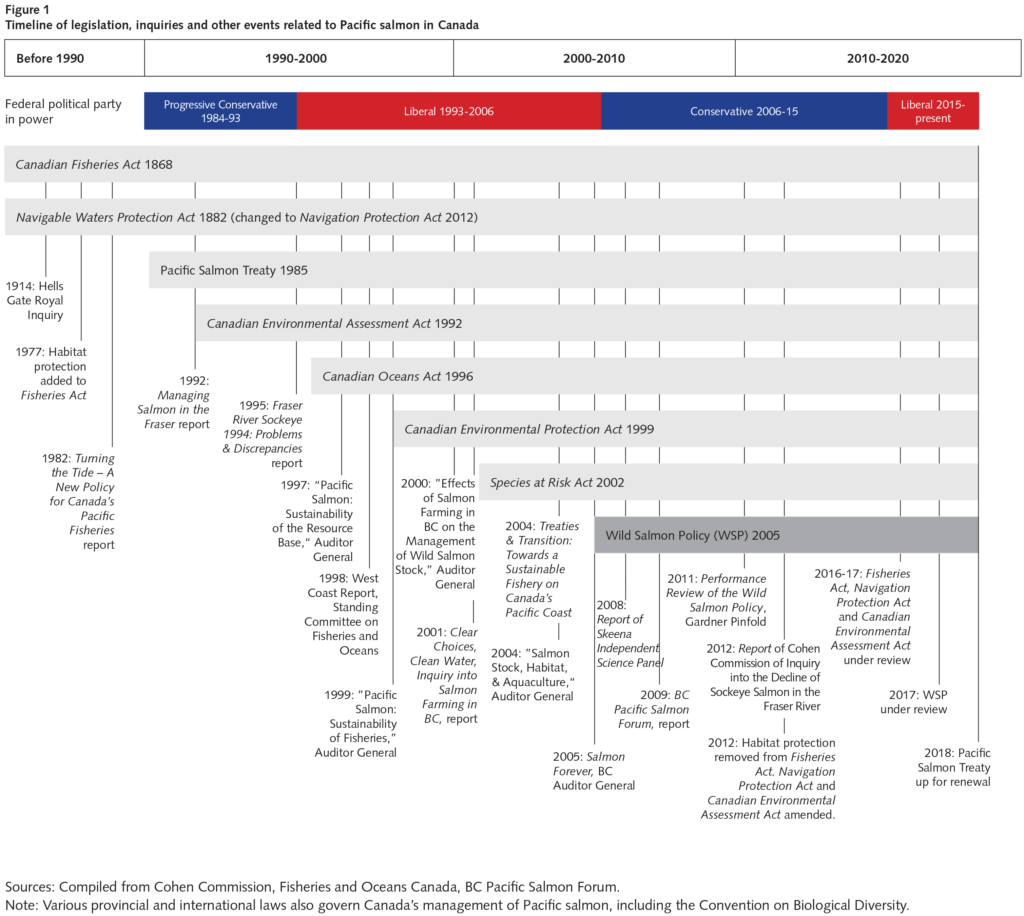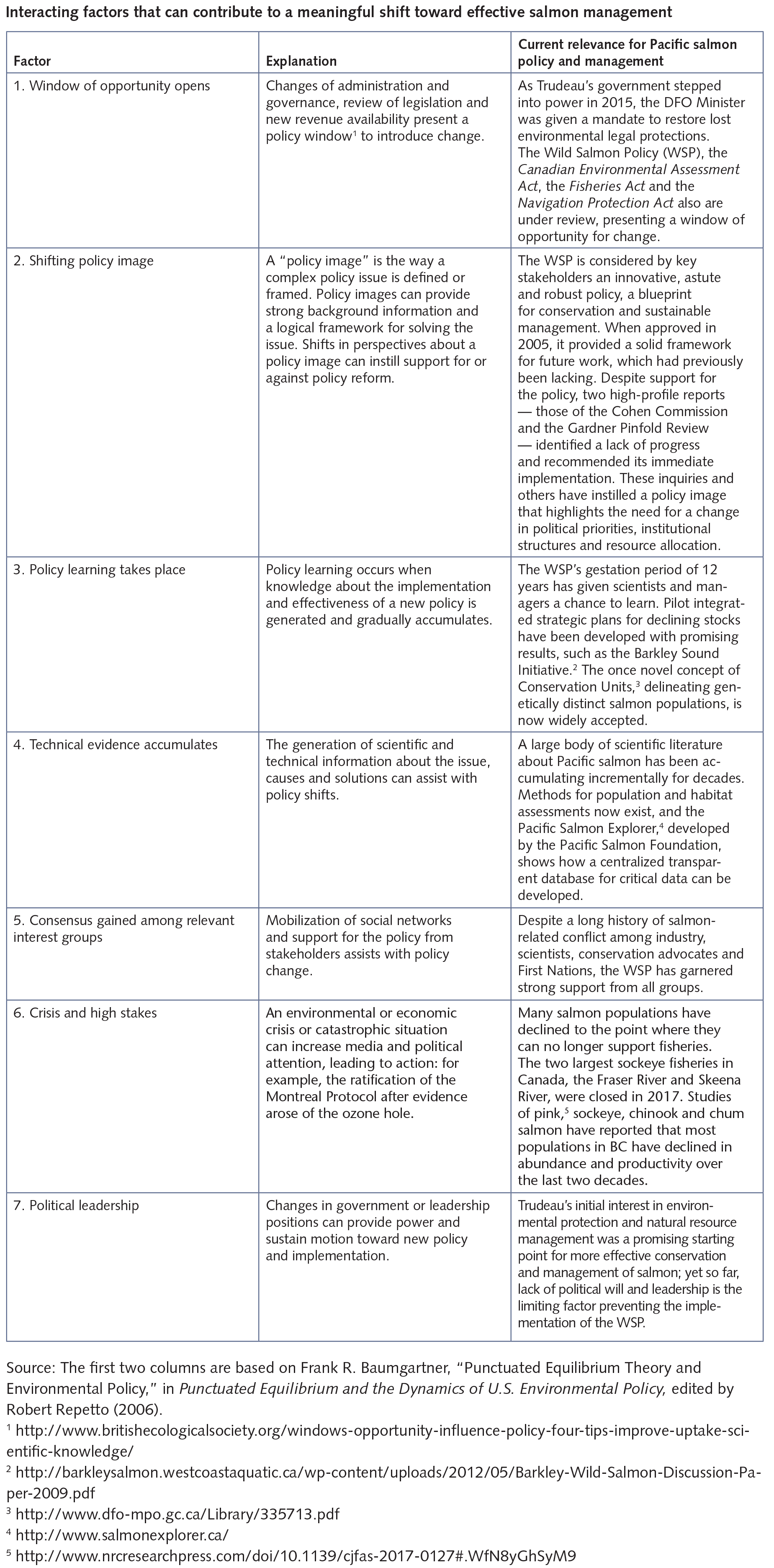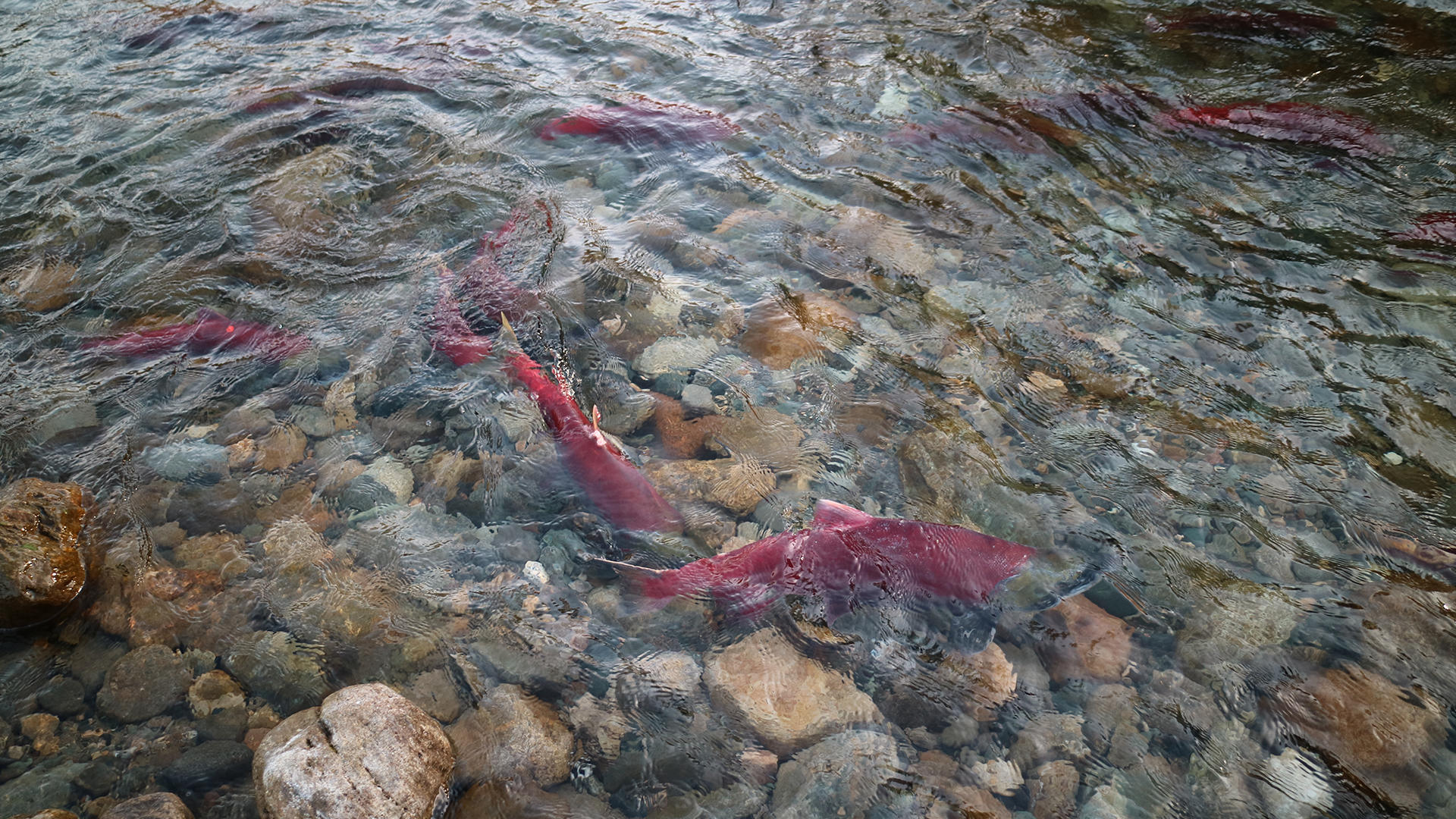
Pacific salmon are considered the most culturally iconic, economically valuable animals on the Canadian West Coast. But many salmon populations have declined in abundance over the last two decades. These two facts may explain why Pacific salmon have been the focus of the highest number of government inquiries of any fish in Canada. Over the past 20 years, more than 20 federal or provincial inquiries have investigated collapses in salmon populations and associated fisheries (figure 1). Cumulatively, these inquests have resulted in over 200 recommendations and cost millions to conduct ($37 million for the 2012 Cohen Commission alone). Despite this effort and investment, very few of these recommendations have been fully implemented.
Amid these investigations, implementation of Canada’s 2005 Policy for the Conservation of Wild Pacific Salmon, known as the Wild Salmon Policy (WSP), has been very slow, even though it was initially hailed as being transformative for the management of Pacific salmon. A formal review of the WSP in 2011 reported that only 4 of 17 action steps had been completed and 10 were partially complete. As an example of the problem, the number of spawning streams that are routinely monitored in the north and central coasts of British Columbia has declined by 34 percent over the past decade.
This slow progress is particularly noteworthy given the current federal political climate. There has been much Canadian environmental policy activity these past two years. The mandate letter to the Minister of Fisheries and Oceans Canada in 2015 specifically directed that recommendations from the Cohen Commission geared toward restoring sockeye salmon stocks in the Fraser River be acted upon. A hiring blitz, adding 135 scientific staff, and increased research funding (an additional $197 million in 2016) at Fisheries and Oceans Canada (DFO) followed. Reviews of major environmental legislation, such as the Canadian Environmental Assessment Act (CEAA) and the Fisheries Act, are ongoing.
The WSP is also under review, with public consultations on a draft implementation plan scheduled for October and November 2017. The outcome of the review will have long-term consequences for the conservation and management of Pacific salmon at national and international levels. For instance, it will set the stage for the renewal of the Pacific Salmon Treaty in 2018 (an agreement that specifies how salmon catches are shared between Canada and the US) and the International Year of the Salmon in 2019. In this article, we draw on political theory to evaluate the prospects for the implementation of the WSP and the factors most likely to support implementation. In doing so, we identify key gaps in the proposed WSP implementation plan that, if unaddressed, could hinder meaningful conservation and management progress.
According to Frank M. Baumgartner’s punctuated equilibrium theory of politics, policy is typically stable, with small incremental shifts fluctuating around a status quo position. Occasionally, several interacting factors can create enough momentum to escape the stable equilibrium and lead to abrupt policy reform. Dramatic policy changes occur rarely and unpredictably, however. Moving away from the status quo toward a different trajectory requires a window of opportunity, coupled with interactions between positive feedback processes. With the exception of the 2012 gutting of the Fisheries Act and the CEAA, the policy for Pacific salmon seems to have been stationary for a decade, meandering from inquiry to inquiry with no substantial effect. A major push is required to break from the current policy stasis, and now may be the time.
It seems that the necessary policy window and the multiple positive reinforcing factors that can lead to such punctuated tipping points in government policy are now aligned for Pacific salmon (see box). First and foremost, the change in government, the current review of the WSP and relevant environmental legislation, and the injection of funding into DFO have produced the most auspicious policy window for salmon seen in a long time (factor 1).
Importantly, several positive feedback processes are in play too, making a new outlook for salmon conservation and management possible. The WSP is innovative, relevant and well designed, and its lack of implementation has not gone unnoticed, demonstrating that a strong but shifting “policy image” exists (factor 2). The necessary science and pilot case studies on how to assess and manage salmon populations have been developed, providing useful technical evidence and policy learning (factors 3 and 4). Critically, there is significant buy-in and support for the policy from key collaborators, including First Nations, industry and communities (factor 5). Finally, many salmon populations have declined in abundance, at considerable environmental, social and economic costs: we are in a situation of high stakes (factor 6).
Despite the alignment of these reinforcing factors, it is unclear whether the key remaining ingredient for meaningful change in salmon policy is present: political will and leadership (factor 7). Although the government has committed to implementing the recommendations from the Cohen Commission and the WSP, there does appear to be a continuing propensity for talk and consultation — that is, more of what is in the timeline — rather than action. The Canadian government is at a crossroads. It now has the potential to deliver a powerful implementation plan, supported by strong leadership and adequate funding to improve the prospects for wild salmon. Alternatively, it could continue to under-deliver with a weak implementation plan, poor leadership and insufficient resources.
Political will and leadership could be extremely important in facilitating the effective implementation of the WSP. This leadership must come from the Minister of Fisheries and Oceans Canada, and it would provide three critical components that the policy is currently lacking: additional dedicated funding and resources, a senior manager, and a strong, detailed implementation plan.
We recommend that adequate annual funding be allocated specifically for monitoring, assessment and management of Pacific salmon. Currently, funding for WSP implementation must be found within the DFO Pacific Region’s existing resources. However, both the Cohen Commission and the Gardner Pinfold Review highlighted that the existing WSP budget envelope is insufficient to implement the policy. Unfortunately, the actual cost to implement the WSP has not been estimated and there are no budgets outlined in the draft implementation plan. The Pacific Salmon Foundation, an independent organization, has demonstrated that the database and status assessment components of the policy can be implemented at a fraction of the cost of commissioning another inquiry. Research suggests an additional $1.2 million per year would provide sufficient monitoring of salmon returning to BC’s north and central coast regions — a small fraction of the funds spent on DFO’s aquaculture program annually (almost $28 million in 2017-18).
This additional investment could be done in partnership with First Nations, through the Indigenous Guardian programs. Such a partnership would support local expertise and stewardship of salmon and their habitats, and it would also align with the federal government’s promise of a renewed relationship with Indigenous peoples.
In agreement with the Cohen Commission and Gardner Pinfold reports, we encourage the government to consider appointing a senior manager with responsibility for WSP implementation. Currently, accountability is spread across multiple DFO sections, with no designated champion to coordinate work. In response to Cohen’s recommendations, last year DFO declared it too expensive to establish a new position. DFO recently confirmed that it will not create such a role, yet stated that this recommendation has been acted on. This “action” — or inaction — calls into question whether the WSP is a high priority for the department.
Finally, the proposed implementation plan requires additional detail to ensure it will lead to positive outcomes. Specifically, the plan needs a transparent budget and a description of how DFO will prioritize assessment and management actions. We, and others, will certainly provide such recommendations during the consultation period this autumn.
Implementing a decade-old policy should not require a rare alignment of multiple factors leading to punctuated change. However, the alignment is there (as shown in table 1): the policy is ready to be implemented, the necessary science is available, and key stakeholders are engaged. What may look like an incremental step — taking political leadership, followed by additional resources, dedicated staff and an improved implementation plan — would be hugely influential. The Minister should recognize that his immediate action will provide long-term benefits for Pacific salmon conservation. We would consider effective implementation a dramatic step forward, regardless of whether it is framed as revolutionary or just good governance.
The authors would like to acknowledge David Rose, Brendan Connors, Katrina Connors and Jonathan Moore for advice on this article.
Photo: Oregon State University (Flickr). ShareAlike 2.0 Generic (CC BY-SA 2.0).
Do you have something to say about the article you just read? Be part of the Policy Options discussion, and send in your own submission. Here is a link on how to do it. | Souhaitez-vous réagir à cet article ? Joignez-vous aux débats d’Options politiques et soumettez-nous votre texte en suivant ces directives.












